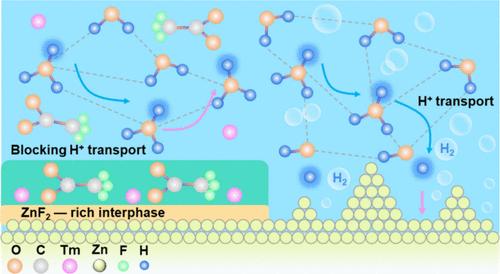阳离子-阴离子协同化学可实现局部贫水和高电位差界面工程,用于稳定的无析氢锌金属阳极
IF 9.1
1区 材料科学
Q1 CHEMISTRY, MULTIDISCIPLINARY
引用次数: 0
摘要
镀锌过程中的析氢反应和不受控制的沉积动力学严重破坏了锌金属阳极的可逆性。内部亥姆霍兹平面和由此产生的固体电解质界面(SEI)是深刻调节HER的关键。我们报道了一种局部贫水、高电位梯度界面设计,使用三氟乙酸铥作为电解质添加剂。三氟乙酸阴离子在锌表面形成阴离子富集层,作为质子阻断屏障并诱导局部缺水界面。这一层与原位的富含znf2的SEI一起抑制了HER的H2O分解。同时,Tm3+介导的双电层增强了Zn2+的输运,并指导了以(002)取向为主的六边形排列Zn的生长。结果表明,在20 mA cm-2 /5 mAh cm-2条件下,锌∥锌对称电池的H2生成可以忽略不计,且具有>;1000 h的稳定性,而锌∥聚苯胺袋电池在1000次循环后仍保持82.3%的容量而不肿胀。这种阳离子-阴离子协同策略为无析氢锌金属阳极提供了一条途径。本文章由计算机程序翻译,如有差异,请以英文原文为准。

Cation–Anion Synergistic Chemistry Enables Localized Lean-Water and High-Potential-Difference Interfacial Engineering for Stable Hydrogen-Evolution-Free Zn-Metal Anodes
The hydrogen evolution reaction (HER) and uncontrolled deposition dynamics during Zn plating severely undermine the reversibility of Zn-metal anodes. The inner Helmholtz plane and resulting solid electrolyte interphase (SEI) are crucial in profoundly regulating the HER. We report a localized lean-water, high-potential-gradient interfacial design using thulium trifluoroacetate as an electrolyte additive. Trifluoroacetate anions form an anion-enriched layer on the Zn surface, serving as a proton-blocking barrier and inducing a locally water-deficient interface. This layer, together with an in situ ZnF2-rich SEI, suppresses HER from H2O decomposition. Concurrently, Tm3+-mediated electric double layers enhance Zn2+ transport and direct the growth of hexagonally arranged Zn with dominant (002) orientation. As a result, Zn∥Zn symmetric cells exhibit negligible H2 generation and >1000 h stability at 20 mA cm–2/5 mAh cm–2, while Zn∥polyaniline pouch cells retain 82.3% capacity without swelling after 1000 cycles. This cation–anion synergistic strategy offers a route to hydrogen-evolution-free Zn-metal anodes.
求助全文
通过发布文献求助,成功后即可免费获取论文全文。
去求助
来源期刊

Nano Letters
工程技术-材料科学:综合
CiteScore
16.80
自引率
2.80%
发文量
1182
审稿时长
1.4 months
期刊介绍:
Nano Letters serves as a dynamic platform for promptly disseminating original results in fundamental, applied, and emerging research across all facets of nanoscience and nanotechnology. A pivotal criterion for inclusion within Nano Letters is the convergence of at least two different areas or disciplines, ensuring a rich interdisciplinary scope. The journal is dedicated to fostering exploration in diverse areas, including:
- Experimental and theoretical findings on physical, chemical, and biological phenomena at the nanoscale
- Synthesis, characterization, and processing of organic, inorganic, polymer, and hybrid nanomaterials through physical, chemical, and biological methodologies
- Modeling and simulation of synthetic, assembly, and interaction processes
- Realization of integrated nanostructures and nano-engineered devices exhibiting advanced performance
- Applications of nanoscale materials in living and environmental systems
Nano Letters is committed to advancing and showcasing groundbreaking research that intersects various domains, fostering innovation and collaboration in the ever-evolving field of nanoscience and nanotechnology.
 求助内容:
求助内容: 应助结果提醒方式:
应助结果提醒方式:


